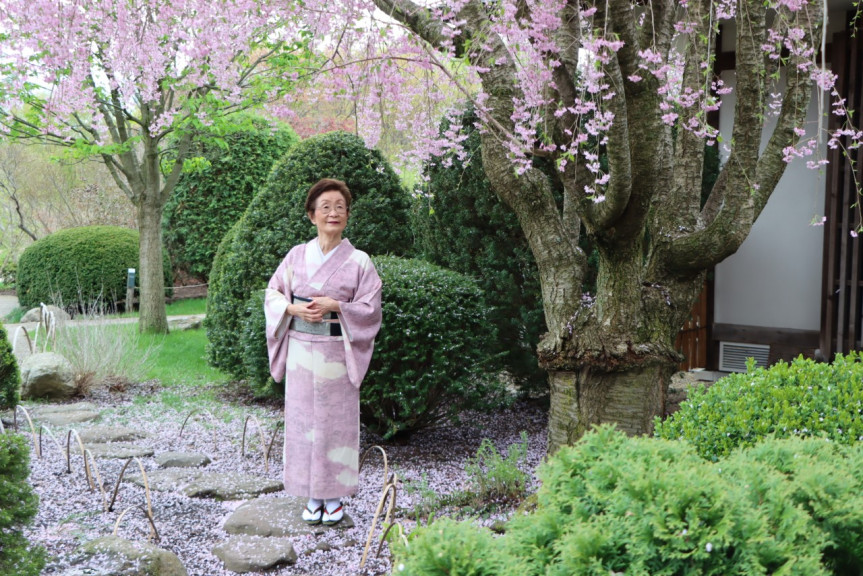Japan House celebrates long history

Professor Emeritus Kimiko Gunji poses near a Cherry Blossom tree at Japan House in Urbana. Photo courtesy of Japan House. Sarah Bond
In 1964, Margaret Erlinger, the head of dance at the University of Illinois, was visiting Japan. There, she saw a man named Shozo Sato perform Kabuki and was enamored.
After talking with Sato, Erlinger asked him if he’d want to come teach at the University of Illinois, and he said yes.
Sato’s teachings at the university led to the establishment of the first Japan House in 1975.
Since then, Japan House has blossomed into a large program and has classes that — according to current director Jennifer Gunji-Ballsrud — have filled up within 30 seconds of registration opening.
Gunji-Ballsrud said Japan House’s mission is to interact with both the campus and the community as a whole and share traditional Japanese arts and culture.
Japan House currently teaches Ikebana flower arranging, Shodo Japanese calligraphy, Sumi-e blacking painting, and the history and concepts of manga and anime.
Gunji-Ballsrud said that when Sato arrived at the university, he started as an artist in residence. People really enjoyed what Sato had to offer, so he was asked if he’d like to stay.
“Essentially, they asked him, ‘What would you like to teach?’ And he said ‘All of it. I’m going to teach all of it,’” Gunji-Ballsrud said.
Gunji-Ballsrud said that Sato could teach everything except for tea ceremonies. They required a lot of setup and it was difficult for Sato to set up temporary make-shift tea rooms.
“He just said ‘Forget it, I can’t do it anymore,’” Gunji-Ballsrud said. “So in his own apartment, he took the second bedroom and changed it into a tea room.”
Word of this reached the university administration. Gunji-Ballsrud said that Morton Weir, a university Vice President at the time, visited Sato.
“Instead of being horrified or disciplinarian or saying ‘You can’t do this,’ (Weir) was like ‘Let’s figure out how we can make this work on campus,’” Gunji-Ballsrud said.
Weir was able to get Sato an old Victorian house on Lincoln Ave., where the Alice Campbell Alumni Center is located now. Using his own funds, Sato renovated the entire first floor of the property into three tea rooms.
“It was really magical,” Gunji-Ballsrud said. “You’d open this big, heavy Victorian door and you would walk in and suddenly feel like you were in Japan.”
In the early 1990s, the university came to Sato and told him that the land Japan House resided on was needed for the alumni center.
Sato chose to retire in 1992. Professor Emeritus Kimoko Gunji, who had been Sato’s assistant for many years, took over as director of Japan House.
Gunji said she began seeking support from the university and outside donors. The university was not willing to provide financial support.
“The university was saying… ‘We cannot help any financial situation, because we cannot just say we are going to support (the) Japan House program (because) then any other country wants to have (the) same thing,’” Gunji said.
Gunji reached out to the Urasenke Foundation of Tea and got two tea rooms donated. Gunji also reached out to the Japan Illini Club of alumni in Japan and received support.
After raising over $2 million in less than two years, Gunji re-approached the university and she was given land down the road at the arboretum on Lincoln Ave. The current Japan House opened on this property in 1998.
Diana Liao, education and engagement specialist for Japan House, said she thinks Gunji has been a great inspiration for many students.
“Professor Gunji has a very deep passion for teaching and sharing traditional Japanese arts and culture,” Liao said. “I’ve actually met students who are much older than me…the most inspirational thing that affected their perspective on life was taking one of Professor Gunji’s classes.”
Sydney Nielsen, junior in LAS, has been taking classes at Japan House since fall of 2021. She did the house’s internship program this past fall, is in Japan House's minor program and has worked as a course assistant.
Nielsen said she has had a lifelong interest in Japanese culture and the Japanese language.
“I kind of knew from the get go, like early high school, that if I came to U of I, Japan House was going to be somewhere I want to get involved with,” Nielsen said.
Japan House currently offers nine classes for university students and two classes for the general community.
The house also has an internship program that began in 2013. According to Japan House’s website, interns develop and implement outreach programs, develop online resources, and handle social media and communications.
Nielsen encourages anyone interested to come to Japan House.
“We always highly encourage attending for the cultural experience and immersion for students as well as community members,” Nielsen said.
Gunji thinks that many interpersonal issues arise because people don’t know how to understand each other and that bridging cultural divides is important.
“We are all (the) same human beings…we have a lot of differences, but if we learn (those) differences, we can all understand much better,” Gunji said.
Japan House is currently celebrating its 25th year at its current location with a Matsuri Festival on Saturday, May 6.

